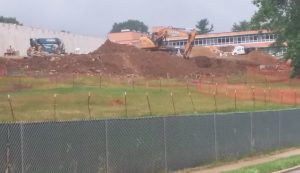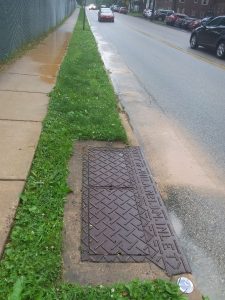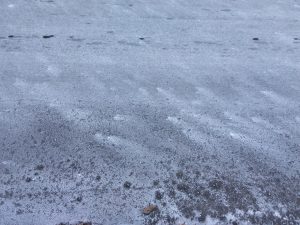Observation in the Basin – A Community Action Story
This guest blog was originally written by Dave Bell, a volunteer with Tookany/Tacony-Frankford partnership (TTF), and published on their website in December 2019. Dave updated the blog in November 2022.
Construction Site Runoff
In 2019 I attended a Streamkeeper training on construction site runoff that was co-sponsored by the Tookany/Tacony-Frankford Watershed Partnership (TTF). Along with Streamkeepers from the Pennypack and Wissahickon watersheds, we learned about best management practices and plans, permitting requirements and compliance, and the negative impacts of poorly maintained erosion and sediment controls on water quality and aquatic life. Staff from Pennypack Ecological Restoration Trust described actual situations and how they responded. At the time, I thought the information was interesting, but didn’t imagine I would ever use it.
 Later that year, I happened to pass by a construction site at the local high school during a rain shower. I saw brown water running off the site, onto the street and into a storm drain adjacent to one of the main headwater tributaries of Tookany Creek. I took pictures and put in a call to the County Soil Conservation District. One of their resource conservationists called me back. I described what I saw and he said there were control measures in place at the site that might have become compromised—he couldn’t use my photos, but would visit the site and let me know what he found.
Later that year, I happened to pass by a construction site at the local high school during a rain shower. I saw brown water running off the site, onto the street and into a storm drain adjacent to one of the main headwater tributaries of Tookany Creek. I took pictures and put in a call to the County Soil Conservation District. One of their resource conservationists called me back. I described what I saw and he said there were control measures in place at the site that might have become compromised—he couldn’t use my photos, but would visit the site and let me know what he found.
 After two weeks, I hadn’t heard from him. I called and he admitted that he hadn’t followed up, but offered to visit the site the following week. Not willing to see another round of sediment entering the creek, I contacted the township. A staff member quickly acknowledged my email, and that afternoon let me know that the township engineer visited the site, found controls that had failed, and watched the contractor correct them. The next time it rained I drove by and saw that water running into the storm drain looked clear.
After two weeks, I hadn’t heard from him. I called and he admitted that he hadn’t followed up, but offered to visit the site the following week. Not willing to see another round of sediment entering the creek, I contacted the township. A staff member quickly acknowledged my email, and that afternoon let me know that the township engineer visited the site, found controls that had failed, and watched the contractor correct them. The next time it rained I drove by and saw that water running into the storm drain looked clear.
Road Salt
Three years ago, I observed a township truck spreading salt on my neighborhood streets ahead of what turned out to be a dusting of snow. The driver spread so much salt it turned the streets white—and chunks of salt went onto the sidewalks and front lawns throughout the neighborhood. I contacted the township public works department and was told they don’t salt ahead of a snow storm, despite my photographic evidence to the contrary. The person I spoke with repeatedly insisted that the salting did not happen, yet offered implausible explanations for how it might have. My favorite was that an unknown former employee took a salting truck out for an unauthorized joy ride.
 Fortunately, a subsequent Streamkeeper training session focused on the Izaak Walton League’s Winter Salt Watch. I learned how snow melt and rain carry road salt (sodium chloride) into our waterways, how chlorides in the creek harm wildlife and degrade water quality, and that watersheds from Harrisburg to Philadelphia (including ours) had high chloride levels the previous winter (230-800 ppm). I signed up for the Winter Salt Watch, received test kits and training, and began monitoring two sites.
Fortunately, a subsequent Streamkeeper training session focused on the Izaak Walton League’s Winter Salt Watch. I learned how snow melt and rain carry road salt (sodium chloride) into our waterways, how chlorides in the creek harm wildlife and degrade water quality, and that watersheds from Harrisburg to Philadelphia (including ours) had high chloride levels the previous winter (230-800 ppm). I signed up for the Winter Salt Watch, received test kits and training, and began monitoring two sites.
Ahead of the 2022-23 winter season, I contacted local officials to let them know I monitor chloride levels in two creeks in the township, that I have found levels to be persistently high and toxic to aquatic life, and that this is a regional problem. My township commissioner asked for details, and I let him know that since I started in the winter of 2019-2020, the baseline chloride level at one site has quadrupled from 43 ppm to 203 ppm. The level after the first rain following a snow event more than doubled from 102 ppm to 237 ppm. The maximum levels I observed were 569 ppm in December 2020 and in excess of 610 ppm (off the scale I was using) in January 2022.
The commissioner and township manager replied that the Public Works Department is “looking at alternatives that may result in our reducing chloride levels from the traditional means of salting roads,” but have yet to provide details. They’re on notice that a resident/taxpayer is watching and will continue to advocate for our watershed.
I didn’t go out looking for these threats to water quality, but Streamkeeper training made me more aware and gave me the tools to address them.